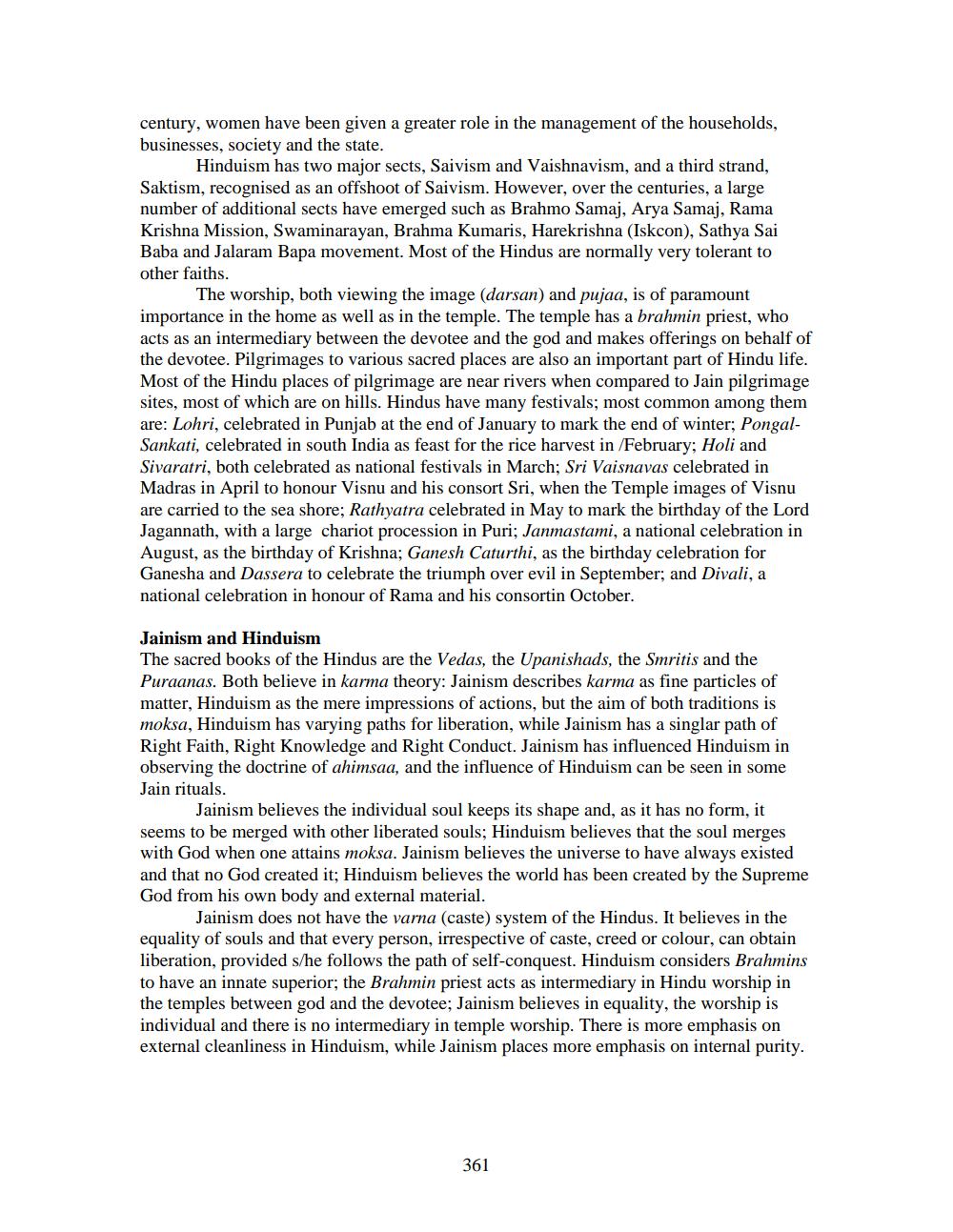________________
century, women have been given a greater role in the management of the households, businesses, society and the state.
Hinduism has two major sects, Saivism and Vaishnavism, and a third strand, Saktism, recognised as an offshoot of Saivism. However, over the centuries, a large number of additional sects have emerged such as Brahmo Samaj, Arya Samaj, Rama Krishna Mission, Swaminarayan, Brahma Kumaris, Harekrishna (Iskcon), Sathya Sai Baba and Jalaram Bapa movement. Most of the Hindus are normally very tolerant to other faiths.
The worship, both viewing the image (darsan) and pujaa, is of paramount importance in the home as well as in the temple. The temple has a brahmin priest, who acts as an intermediary between the devotee and the god and makes offerings on behalf of the devotee. Pilgrimages to various sacred places are also an important part of Hindu life. Most of the Hindu places of pilgrimage are near rivers when compared to Jain pilgrimage sites, most of which are on hills. Hindus have many festivals; most common among them are: Lohri, celebrated in Punjab at the end of January to mark the end of winter; PongalSankati, celebrated in south India as feast for the rice harvest in /February; Holi and Sivaratri, both celebrated as national festivals in March; Sri Vaisnavas celebrated in Madras in April to honour Visnu and his consort Sri, when the Temple images of Visnu are carried to the sea shore; Rathyatra celebrated in May to mark the birthday of the Lord Jagannath, with a large chariot procession in Puri; Janmastami, a national celebration in August, as the birthday of Krishna; Ganesh Caturthi, as the birthday celebration for Ganesha and Dassera to celebrate the triumph over evil in September; and Divali, a national celebration in honour of Rama and his consortin October.
Jainism and Hinduism
The sacred books of the Hindus are the Vedas, the Upanishads, the Smritis and the Puraanas. Both believe in karma theory: Jainism describes karma as fine particles of matter, Hinduism as the mere impressions of actions, but the aim of both traditions is moksa, Hinduism has varying paths for liberation, while Jainism has a singlar path of Right Faith, Right Knowledge and Right Conduct. Jainism has influenced Hinduism in observing the doctrine of ahimsaa, and the influence of Hinduism can be seen in some Jain rituals.
Jainism believes the individual soul keeps its shape and, as it has no form, it seems to be merged with other liberated souls; Hinduism believes that the soul merges with God when one attains moksa. Jainism believes the universe to have always existed and that no God created it; Hinduism believes the world has been created by the Supreme God from his own body and external material.
Jainism does not have the varna (caste) system of the Hindus. It believes in the equality of souls and that every person, irrespective of caste, creed or colour, can obtain liberation, provided s/he follows the path of self-conquest. Hinduism considers Brahmins to have an innate superior; the Brahmin priest acts as intermediary in Hindu worship in the temples between god and the devotee; Jainism believes in equality, the worship is individual and there is no intermediary in temple worship. There is more emphasis on external cleanliness in Hinduism, while Jainism places more emphasis on internal purity.
361




